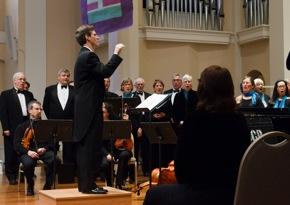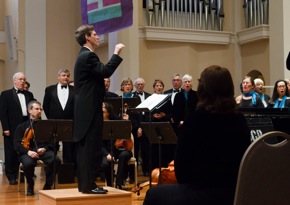Vivaldi wrote so few sacred works (72), relative to his prodigious instrumental output and 46 operas, that it’s curious that it wasn’t until last Saturday that a significant church composition of his was performed here for the first time. Chora Nova performed Vivaldi’s Dixit Dominus, RV 807, accompanied by a period instrument orchestra, in Berkeley’s First Congregational Church, and it is a work of high quality.
This large setting of Psalm 110 — “The Lord said unto my Lord: Sit thou on my right hand until I make thine enemies thy footstool ...” — was identified (that is, discovered) only six years ago. In eight movements for two sopranos, countertenor, chorus, and small orchestra, it’s a much more substantial work than the same composer’s most popular sacred work, the Gloria, RV 489.
It would seem to be a late work, judging by the strong character of the themes as well as the energy and variety in the rhythm. The opening chorus has an assertive theme on the line “sede a dextris meis” (Sit at my right hand) and a similar striding motive in the succeeding soprano solo, “Virgam viritutis.” The solo writing tends toward the virtuosic, reflecting Vivaldi’s operatic style, while the tenor aria, “Dominus a dextris tuis,” whose vigorous passagework was sung securely by Brian Thorsett, recalls the Handelian style.
Vivaldi’s flair for the pictorial and dramatic is in play during this work. The chorus “Judicabit,” which describes the dread vengeance of the Lord, is first signaled by a heralding trumpet call and then picked up in the intensity of the repeated rhythmic figure. There followed the finest vocal solo of the night as Chora Nova’s conductor, Paul Flight, turned to the audience and sang in a fine, fluid countertenor the extended long phrases of “De torrente in via bibet” (He shall drink the water of the brook), accompanied by a repeated pattern of a soft, wavelike figure.
The piece concluded, as all psalm settings do, with the Lesser Doxology, “Gloria Patri et Filio ...” (Glory be to the Father and the Son ...), the music for the chorus strong, with vigorous accompaniment, leading to an “Amen” on cascading runs, tight counterpoint, and a run-them-out coda in cut time.
Intonation and Diction
In this and the other two works of the evening, Chora Nova, a mixed volunteer chorus of 53, produced a good, balanced sound. If it didn’t seem to have a big reserve of power, its intonation was excellent and the sectional blend good. Flight conducted well, with appropriate tempos. His training of the chorus seemed fine, apart from one shortcoming made more apparent by the reverberant acoustics in the First Congregational Church: the choir’s diction. This deficiency was important, not because the audience was expecting to understand the Latin of the mostly unfamiliar texts (which many were following in the printed programs, in any case). Vivaldi, like Pergolesi (in Confitebor tibi Dominus) and Baldassare Galuppi (Nisi Dominus), derived the principal rhythm of his vocal writing from the word-rhythm. If the singing is not articulate, neither is the rhythm.
One other thing should be mentioned. The three soloists were seated at the far stage right of the chorus, necessitating their having to walk to and fro to the center position between movements. This undid the continuity and sense of unity in the three works of the evening, most importantly the Vivaldi.
Galuppi, though an eminent composer in the middle of the 18th century, with especially popular operas, is rarely performed today — perhaps never in the Bay Area, so far as I can remember. On Saturday, Chora Nova performed his Nisi Dominus, Psalm 127. It’s a lively work, at least, in the early Classical style, and more harmonic in style than Vivaldi, with whole movements repeated, for a light and buoyant effect. A soprano solo and two duets draw the operatic passagework into the singing, especially a strong solo, “Sicut sagittae,” and the soprano duet for the first phrase of the “Gloria Patri” running along in decorative triplet passages.
In his pathetically short 26 years of life, Pergolesi’s melodic genius inspired a fair amount of handsome music and some that is beautiful. The setting of the Psalm begins with a single plainchant line, a strong opening chorus that continues to a soprano solo and a choral response that is a harmonized melody. The work finds a dramatic climax in the final movement, “Sanctum et terrible nomen eius,” for countertenor (here sung by a soprano) and a tenor duet. The closing “Gloria Patri” has qualities that begin to suggest Mozart, and the final Amen calls for rousing florid work by the soprano. It’s an expressive, melodious work.
Soprano Jennifer Paulino’s voice has a fine-textured tone, focused and even. Her singing was expressive, her technique fluent. Michele Byrd’s soprano is very bright with a focus that comes to an almost metallic edge. She met the challenges of florid passagework readily, in satisfying performances. Brian Thorsett’s tenor is pleasing, even a little grainy rather than bright and forward, his singing poised. The small orchestra of period instrument musicians, well-known hereabouts, performed very well.


